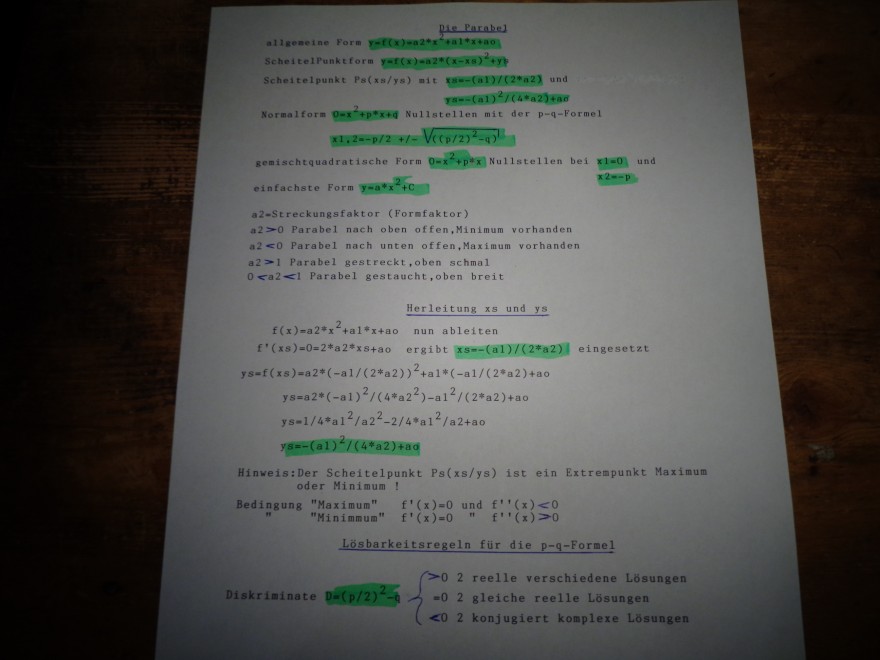K(x)=0,1*x²+6*x+40 ist eine Parabel nach oben offen,Minimum vorhanden
allgemeine Form y=f(x)=a2*x²+a1*x+ao
a2>0 Parabel nach oben offen,Minimum vorhanden
a2<0 Parabel nach unten offen,Maximum vorhanden
Scheitelpunktform y=f(x)=a2*(x-xs)²+ys
Scheitelpunkt Ps(xs/ys) mit xs=-(a1)/2*a2) und ys=-(a1)²/(4*a2)+ao
xs=-(6)/(2*0,1)=-30 und ys=-(6)²/(4*0,1)+40=-50
K(x)=0,1*(x-(-30))²-50=0,1*(x+30)²-50
x>-30 k´(x)=m>0 → monoton steigend
Definitionsbereich 0≤x≤30 bei x=0 keine Produktion bei x=30 maximale Produktion
Fixkosten,wenn nix produziert wird bei x=0 K(Fix)=40
Krümmung k=y´´/[1+(y´)²]^(3/2)
k<0 konvex (Rechtskrümmung,von oben gesehen)
k>0 konkav (Linkskrümmung,von oben gesehen)
also y´´=K´´(x)=...
b) K(x)=150=0,1*x²+6*x+40
0=0,1*x²+6*x+40-150
0=0,1*x²+6*x-110 dividiert durch 0,1
0=x²+60*x-1100 Nullstellen mit der p-q-Formel x1,2=-p/2+/-Wurzel((p/2)²-q)
mit meinem Graphikrechner (GTR,Casio)
x1=14,721 ME und x2=-74,721..
K(10)=0,1*10²+6*10+40=110 GE
c) weiß ich nicht,weil das Spezialwissen voraussetzt
Preisuntergrenze ist wohl bei x=0 → Fixkosten K(Fix)=40 GE

Text erkannt:
Die Parabe] al 1geneine Form \( y=f(x)=a 2 * x^{2}+a 1+x+a 0 \) ScheitelPunktform \( \left.y=f(x)=a 2^{*}(x-x 8)^{2}+y\right\} \) Scheite1punkt \( \mathrm{Ps}(\mathrm{xs} / \mathrm{ys}) \mathrm{mit} \mathrm{xse-}(\mathrm{a} 1) /(2 * \mathrm{a} 2) \) und
\( \mathrm{y} \mathrm{se-}(\mathrm{a} 1)^{2} /(4 * \mathrm{a} 2)+\mathrm{ad} \)
Normalform \( 0=x^{2}+p^{*} x+d \) Nullstellen mit der p-q-Formel \( x+2=-p / 2+/-\sqrt{\left((p / 2)^{2}-q\right)} \)
gemischtquadratische Form \( \left.0=x^{2}+p^{*} x\right] \) Nu11stellen bei \( x 1=0 \) und
einfachste Form \( y=a^{*} x^{2}+c \)
a 2-Streckungsfaktor (Formfaktor) \( a 2>0 \) Parabel nach oben offen, Minimum vorhanden a \( 2<0 \) Parabel nach unten offen,Maximum vorhanden \( a 2>1 \) Parabel gestreckt,oben schmal 0 <a \( 2<1 \) Parabel gestaucht,oben breit
Herleitung \( \mathrm{xs} \) und ys
\( f(x)=a 2^{*} x^{2}+a 1^{*} x+a \circ \) nun ableiten
\( f^{\prime}(x s)=0=2 * a 2 * x s+a 0 \quad \) ergibt \( \left.x s=-(a 1) /(2 * a 2)\right] \) eingesetzt
\( y s=f(x s)=a 2 *(-a 1 /(2 * a 2))^{2}+a 1 *(-a 1 /(2 * a 2)+a 0 \)
\( y s=a 2 *(-a 1)^{2} /\left(4 * a 2^{2}\right)-a 1^{2} /(2 * a 2)+a 0 \)
\( \mathrm{ys}=1 / 4 * \mathrm{a} 1^{2} / \mathrm{a} 2^{2}-2 / 4 * \mathrm{a} 1^{2} / \mathrm{a} 2+\mathrm{a} \circ \)
\( y s=-(a 1)^{2} /(4 * a 2)+a d \)
Hinweis:Der Scheitelpunkt \( \mathrm{Ps}(\mathrm{xs} / \mathrm{ys}) \) ist ein Extrempunkt Maximum oder Minimum
Lösbarkeitsregeln für die p-q-Formel
Diskriminate \( D=(p / 2)^{2}-b\left\{\left\{\begin{array}{l}>02 \text { reelle verschiedene Lösungen } \\ =02 \text { gleiche reelle Losungen } \\ <02 \text { konjugiert komplexe Losungen }\end{array}\right.\right. \)
~plot~0,1*x^2+6*x+40;150;310;[[-60|40|-60|350]];x=14,72;x=30~plot~